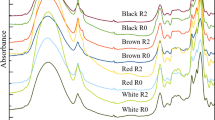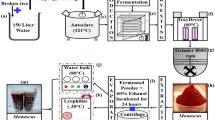Abstract
A HPLC-based method for the analysis of red fermented rice and results obtained with it are presented. Formation of citrinin, red, orange and yellow pigments byMonascus depends on the culture substrate. Citrinin and some pigments are decomposed by heat. A newMonascus metabolite, monascodilone, its structure and preliminary data on its toxicity are reported.
Similar content being viewed by others
References
Ma J, Li Y, Ye Q, Li J, Hua Y, Ju D, Zhang D, Cooper R, Chang M (2000) Constituents of red yeast rice, a traditional food and medicine.J. Agric. Food Chem., 48: 5220–5225.
Juzlová P Martinková L, Kren V (1996) Secondary metabolites of the fungusMonascus- a review.J. Industrial Microbiol, 16: 163–170.
Martinková L, Juzlová P, Vesely D (1995) Biological activity of polyketide pigments produced by the fungusMonascus.J. Appl. Microbiol., 79: 609–616
Blanc PJ, Loret MO, Goma G (1995) Production of citrinin by various species ofMonascus.Biotechnol. Lett., 17: 291–294.
Nozaki H, Date S, Kondo H, Kiyohara H, Takaoka D, Tada T, Nakayama M (1991) Ankalactone, a new α ß-unsaturated ϰ-lactone fromMonascus anka.Agric. Biol. Chem., 55: 899–900.
Endo A, Komagata D, Shimada H (1986) Monacolin M, a new inhibitor of cholesterol biosynthesis.J. Antibiot., 39: 1670–1673.
Martinková L, Patáková-Juzlová P, Kren V, Kucerová Z, Havlicek V, Olsovsky P, Hovorka O, Rihová B, Vesely D, Veselá D, Ulrichová, J Prikrylová V (1999) Biological activities of oligoketide pigments ofMonascus purpureus.Food Add. Contam., 16: 15–24.
Hossain CF, Okuyama E, Yamazaki M (1996) A new series of coumarin derivatives having monoamine oxidase inhibitory activity fromMonascus anka.Chem. Pharm. Bull, 44: 1535–1539.
Wang IK, Lin-Shiau SY,. Chen PC, Lin JK (2000) Hypotriglyceridemic effect of Anka (a fermented rice product ofMonascus sp.) in rats.J. Agric. Food Chem., 48: 3183–3189.
Fink-Gremmels J, Dresel J, Leistner L (1991) Use of Monascus extracts as an alternative to nitrite in meat products.Fleischwirtschaft 71: 1184–1186
Wild D (2000) Rotschimmelreis: Inhaltsstoffe und Anwendung in Fleischerzeugnissen.BAFF Mitteilungsblatt, 39, Nr. 148, 701–706
Wild D, Tóth G, Humpf H-U (2002) A new Monascus metabolite isolated from red yeast rice (angkak, red koji).J. Agric. Food Chem., 50: 3999–4002
Hanelt M, Gareis M, Kollarcik B (1994) Cytotoxicity of mycotoxins evaluated by the MTT cell culture assay.Mycopathologia, 128: 167–174
Author information
Authors and Affiliations
Rights and permissions
About this article
Cite this article
Wild, D., Gareis, M. & Humpf, H.U. Analyses of red fermented rice (angkak) and report of a newMonascus metabolite. Mycotox Res 18 (Suppl 2), 212–216 (2002). https://doi.org/10.1007/BF02946098
Issue Date:
DOI: https://doi.org/10.1007/BF02946098




